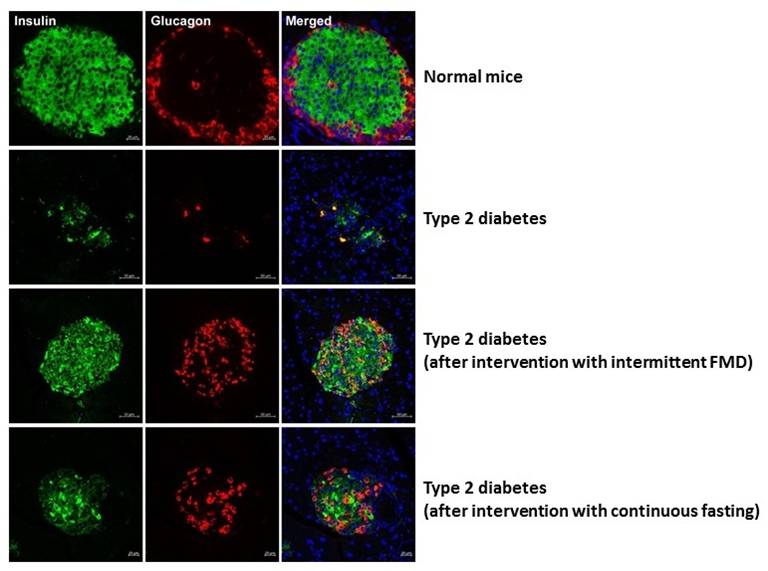A Study Reveals Benefit of Intermittent Calorie Restriction in Diabetes Intervention as Compared to Continuous Calorie Restriction
Calorie restriction (CR) has long been considered as an effective intervention strategy that can improve metabolism and prolong life span. In recent years, the concept of intermittent CR has drawn attention because of the difficulty of continuous CR every day in practice. However, few study has directly compared the intermittent CR versus continuous CR in the past.
Dr. CHEN Yan's team in Shanghai Institute of Nutrition and Health of the Chinese Academy of Sciences, systematically analyzed the intervention effects of various diet regimens on diabetes mellitus using STZ-induced type 1 diabetic mouse model and the db/db type 2 diabetic mouse model. This study conducted intermittent CR in mice by using a "fasting-mimicking diet" (FMD). The FMD is rich in many plant ingredients and fiber, while low in protein.
Firstly, researchers compared the effects of different regimens of intermittent CR on diabetes, i.e. 2-5 and 5-9 regimens. The 2-5 regimen means using FMD for 2 days followed by 5 days of free eating whereas the 5-9 regimen means using FMD for 5 days followed by 9 days of free eating. When using FMD, the total calorie intake was 1/3 of the normal intake. In both diabetic mice models, both regimens significantly reduced fasting blood glucose, but in type 2 diabetic mice, the 5-9 regimen was better than the 2-5 regimen.
They carefully compared the effects of intermittent CR and continuous CR on diabetes mellitus. Mice fed with continuous CR had the same total calories intake as those of intermittent CR. In the type 1 diabetic mice, both intermittent CR and continuous CR could significantly reduce fasting blood glucose, improve glucose tolerance and increase insulin sensitivity. There was no significant difference between the two types of CR. However, in the type 2 diabetic mice, the intervention effect of intermittent CR was better than continuous CR, reflected by better control in fasting blood glucose, glucose tolerance and insulin sensitivity.
Researchers found the possible mechanisms to understand the intervention activity of intermittent CR. Intermittent CR significantly increased the number of β cells, the insulin-secreting cells, in the pancreatic islets. In addition, intermittent CR could increase the insulin sensitivity of these tissues in the liver and skeletal muscle. Therefore, these findings suggest that intermittent CR may interfere with the progression of diabetes by increasing the number of islets β cells and enhancing the insulin sensitivity of peripheral tissues.
They also made other interesting discoveries in the related research. For a long period of time, people have believed that diet can alleviate diabetes because it reduces bodyweight. In this study, they found that intermittent CR did not control diabetes by reducing the bodyweight. For example, in type 2 diabetic mice fed with 5-9 regimen, intermittent CR did not reduce body weight, while continuous CR could reduce body weight. However, intermittent CR was better than continuous CR in controlling diabetes. In addition, by comparing intermittent CR using FMD and that intermittent CR using normal chow, they found that both intermittent CR could reduce fasting blood glucose, but the improvement of insulin sensitivity is better when using FMD.
This study reveals that intermittent CR is an effective nutritional intervention strategy for diabetes mellitus. Due to the efficiency of 2-5 diet regimen in controlling diabetes mellitus, and considering that 2-day diet control in a week is easily accepted in practice, this study would pave a way for future intervention trials in human patients.
The study was published in Nutrition and Metabolism on Aug 28th, 2019 with the title of "Comparison of glycemic improvement between intermittent calorie restriction and continuous calorie restriction in diabetic mice". It was supported by the National Natural Science Foundation of China, the Ministry of Science and Technology and the Chinese Academy of Sciences.

Fluorescent staining of the pancreatic islets. (Image by Dr. Chen's Group)
Media Contact:
WANG Jin (Ms.)
Shanghai Institute of Nutrition and Health,
Chinese Academy of Sciences
Email: sibssc@sibs.ac.cn
